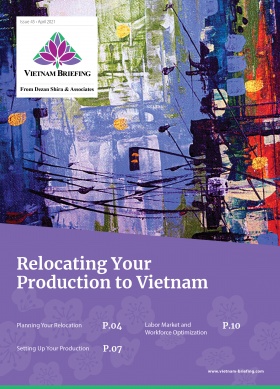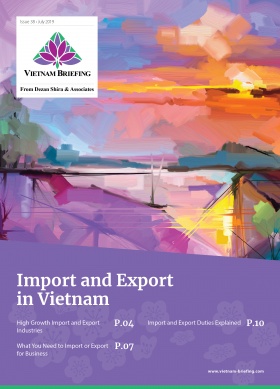Vietnam’s High Growth Import and Export Industries
- Vietnam’s economy is expected to grow by 6.5 percent in 2021 subject to how the country can control the latest COVID-19 outbreak
- The US remains Vietnam’s biggest export market, followed by China and the EU.
- We look at Vietnam’s sustainable trade industries suited for high-growth import and export.
The US was Vietnam’s largest export market in the first four months of the year with a value of US$30.3 billion, up 50 percent year-on-year with China coming in at second, followed by the EU according to Vietnam’s General Statistics Office (GSO).
We examine the five most sustainable trade industries, suited for high-growth export and import.
Electronics
Vietnam has emerged as a major electronics exporter, with electrical and electronic goods overtaking textiles, coffee, and rice to become the top export item.
This has been attributed to increased imports from several Asian countries including, Japan, South Korea, and China. In 2019, electronics accounted for 36 percent of the country’s exports, up 1.15 percent in 2018. To move domestic manufacturing up the value chain, many companies in the country are investing in machinery and technology to support more exports.
Currently, 95 percent of electronic exports are dominated by foreign-invested businesses, particularly those that produce smartphones and CCTVs. Vietnam relies heavily on imported machinery and equipment from China, followed by South Korea and Japan, in this industry.
Businesses that need to import machinery to produce electronics should note that the authorities passed Decree No 18/2019/QD/TTg to ban the import of outdated, poor quality, and unsafe equipment.
Footwear
The footwear industry has benefited from several favorable factors throughout its growth in the country. The EU-Vietnam free trade agreement (EVFTA) is expected to significantly help the sector. Top footwear exports were to China, the EU, and the US. Major US footwear companies such as Nike and Sketchers have already shifted production to Vietnam. The Producers Guild of America (PGA) is also working on a tax bill that will cut tariffs on several lines of imports that include footwear and textile produced from Vietnam.
Vietnam is able to supply leather materials and accessories for the footwear market. It’s forecast that Vietnam will be able to supply 60 percent of the leather materials required domestically by 2030, compared to the 45 percent manufacturers sourced locally in 2018. Footwear and leather exports hit nearly US$16.5 billion in 2020, down 10 percent due to the pandemic.
Due to the disruption caused by the pandemic, Vietnam Leather, Footwear and Handbag Association (LEFASO) noted that local firms should take advantage of the opportunities such as the free trade agreements and US-China tensions to boost productivity and exports. The industry still needs to address increasing labor costs, and the Industry 4.0 question mark, but many analysts expect the industry to remain competitive for the next two decades.
Garment and textiles
Vietnam has approximately 6,000 garment and textile manufacturing companies employing 2.5 million people, and its top export destinations are leading consumer markets – the US, Europe, Japan, and South Korea.
The industry’s growth is also being fueled by increased domestic consumption, fueled by a young demographic, and increasing urbanization. Retail sales are growing at a rate of 20 percent annually and are forecast to expand, thanks to several free trade agreements.
Germany-based Amann Group and US-based Kraig Biocraft Laboratories are among the companies that are poised to scale up manufacturing production in Vietnam. Due to the US-China trade war, the help of Vietnam’s FTAs, analysts believe the industry will maintain high growth potential, with a forecast export turnover of US$200 billion until 2035.
Furniture, prefabricated buildings
Furniture, lightings, and prefabricated buildings feature high on Vietnam’s export list. The sector accounted for 4.4 percent of Vietnam’s exports in 2020. The effect of the Comprehensive and Progressive Agreement for Trans-Pacific Partnership (CPTPP) and EVFTA is further expected to propel Vietnam as the second-largest interior furniture exporter after China in the next seven to eight years with new markets in Canada and Mexico, apart from traditional markets like the US, EU, China, and South Korea. The industry is expected to grow by 16 percent year on year. Even with this growth, the furniture industry remains small and has immense potential to become a major supplier and exporter.
The same can be said about prefabricated buildings, which are building structures that are manufactured offsite and transported for onsite assembly. Such types of buildings are gaining in popularity not only in the commercial sector but also in the residential living space. The government wants the building materials sector to achieve a higher level of automation by 2030.
Oil
As the country grows, its energy needs grow as well. Between 2012 and 2017, Vietnam exported more oil than it imported, with average exports at about 8.3 million tons a year and imports at 750,000 tons a year. This trend reversed in 2018, with imports at 5.17 million tons and exports at 3.96 million tons, down 41.8 percent compared to the previous year.
This trend is likely to continue, particularly due to the demand for jet fuel. With more tourists, the aviation industry is growing significantly, leading to higher fuel consumption. While Vietnam started two refineries in 2018, they mainly produce gasoline and diesel; demand for jet fuel will continue to remain from existing suppliers like Singapore, Thailand, and China. While it’s true that oil demand has been significantly affected by border closures and covid-related restrictions, it will change once the pandemic is brought under control.
Vietnam’s oil industry remains heavily state-controlled. To address falling oil output and meet demand, Vietnam will need to explore untapped deep waters as compared to its present shallow southern basins. Long-term gas development will largely depend on government commitment to monetize reserves and taking a hit on prices. Vietnam is also a big oil importer due to the lack of its refining capacity.
With domestic consumption growing faster than China due to a surging economy, petroleum product demand is expected to rise 660,000 barrels of oil per day in 2030. While Vietnam has the resources to meet future needs it will need to attract private investment with the right regulations and policies to meet growing energy demand.
About Us
Vietnam Briefing is produced by Dezan Shira & Associates. The firm assists foreign investors throughout Asia from offices across the world, including in Hanoi, Ho Chi Minh City, and Da Nang. Readers may write to vietnam@dezshira.com for more support on doing business in Vietnam.
We also maintain offices or have alliance partners assisting foreign investors in Indonesia, India, Singapore, The Philippines, Malaysia, Thailand, Italy, Germany, and the United States, in addition to practices in Bangladesh and Russia.
- Previous Article Why Investors Should Consider Vietnam’s Electric Vehicle Market
- Next Article Opportunities in Vietnam’s Northern Key Economic Region







